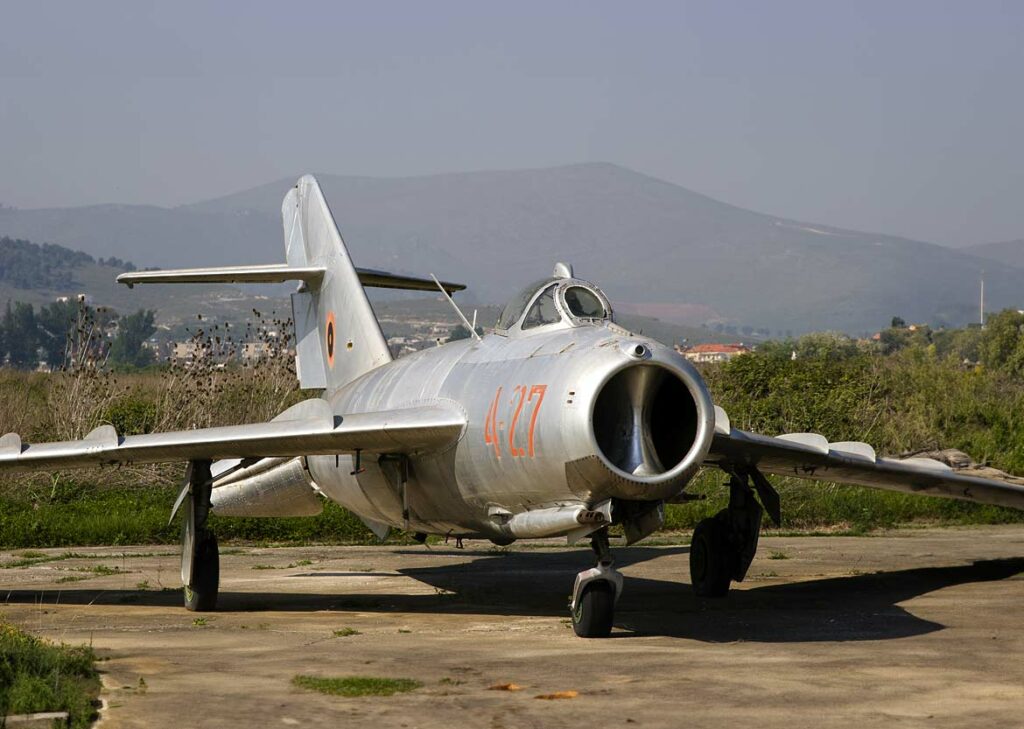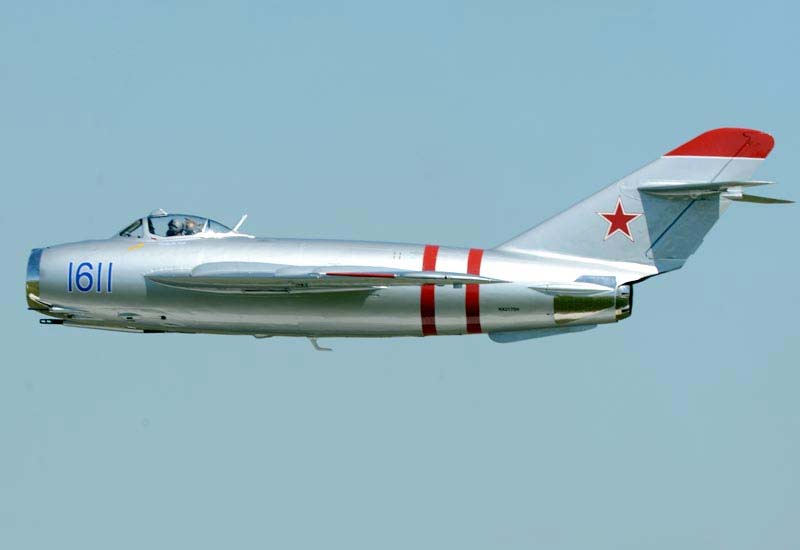The Shenyang J-5 (Fresco) is a Chinese-built single-seat jet interceptor and fighter derived from the Soviet Mikoyan-Gurevich MiG-17, featuring a swept-wing design and turbojet propulsion.
In Brief
The Shenyang J-5, known to NATO as the Fresco, is a single-seat jet fighter developed in China based on the Soviet MiG-17. It first flew on July 19, 1956, and featured a Wopen WP-5 turbojet engine providing a thrust of 5,730 lbs (25.5 kN) dry and 7,600 lbs (33.8 kN) with afterburning. The J-5 had a maximum speed of 700 mph (1,130 km/h) and a service ceiling of 54,100 ft (16,500 m). Its armament included 3 Type 23-1 23 mm cannons. The J-5’s dimensions were a length of 11.09 m (36 ft 5 in), a wingspan of 9.628 m (31 ft 7 in), and a height of 3.8 m (12 ft 6 in). With an empty weight of 3,939 kg (8,684 lb) and a gross weight of 6,000 kg (13,228 lb), it was used by several countries and manufactured in significant numbers.
The Shenyang J-5 Fresco was a crucial development in the history of Chinese aviation, marking China’s entry into the era of jet fighters. Derived from the Soviet Mikoyan-Gurevich MiG-17, the J-5 played a vital role in modernizing the People’s Liberation Army Air Force (PLAAF) and other air forces around the world.

History of Development
The development of the Shenyang J-5 began in the early stages of the Cold War when China, aligned with the Soviet Union, sought advanced military technology. The Soviet MiG-17 Fresco, a jet-powered, swept-wing fighter, was one of the key developments transferred to China. The Chinese produced local versions of this aircraft, initially designated as Dongfeng-101 (East Wind-101) and Type 56, and later as the J-5 after 1964.
The J-5’s first flight occurred on July 19, 1956, and it entered service shortly thereafter. The Sino-Soviet Split in the 1960s led to a slowdown in the development of the MiG-17PF (J-5A) variant, but the production eventually resumed, resulting in the J-5 and J-5A entering service. Export models were designated as F-5, and a two-seat trainer version, the JJ-5 (FT-5), was also developed and produced.
Throughout its service life, the J-5 was used by various air forces, including North Korea, Pakistan, and several African nations. Despite being considered obsolete by the 1970s and 1980s, the J-5 continued to serve in some air forces due to its reliability and simplicity.
Design
The Shenyang J-5 closely resembled its Soviet counterpart, the MiG-17. The design included a tubular fuselage with a bifurcated intake at the nose and an exhaust port under the tail fin. The pilot sat under a heavily framed canopy, providing adequate forward and midship views. The J-5’s swept-back wing mainplanes were mid-mounted along the fuselage sides, featuring prominent boundary layer fences for improved aerodynamic performance.
The aircraft’s undercarriage was wheeled and fully retractable, with main legs under the wing elements and a nose leg under the nose section. The J-5’s armament consisted of a 37mm Type 37 autocannon and two 23mm Type 23-1 autocannons mounted in the nose above and below the intake.
The J-5 measured 11.5 meters in length, had a wingspan of 9.6 meters, and stood 3.8 meters tall. Its empty weight was 4,080 kg, with a maximum takeoff weight (MTOW) of 6,215 kg. The Wopen WP-5 turbojet engine provided a maximum speed of 1,050 kph, a range of 1,230 kilometers, and a service ceiling of 47,000 feet.
Performance
The Shenyang J-5’s performance was characterized by its relatively high speed, maneuverability, and effective armament. Its Wopen WP-5 turbojet engine allowed for a maximum speed of 652 mph (1,050 kph), a service ceiling of 46,916 ft (14,300 m), and a rate of climb of 5,315 ft/min (1,620 m/min). The J-5 had a range of 764 miles (1,230 km), which could be extended with drop tanks.
While the J-5 was effective in its day, it eventually became outclassed by newer, more advanced fighter aircraft. Nevertheless, its performance made it a valuable asset for countries with limited access to more modern fighters.
Variants
The Shenyang J-5 had several variants, including:
- J-5 (Fresco-A): Base series designation.
- J-5A (Fresco-C): Equivalent to the Soviet MiG-17PF, equipped with radar.
- JJ-5 (FT-5): Two-seat trainer aircraft developed by Chengdu.
- J-5 TB: Modified for torpedo delivery, with reduced armament and operational range.
- F-5: Export designation for single-seat fighters.
- FT-5: Export designation for JJ-5 trainers.
Each variant catered to specific roles, ranging from basic fighter and interceptor to advanced trainer models.

Military Use and Combat
The Shenyang J-5 saw extensive service with various air forces, including China, North Korea, Pakistan, Sri Lanka, Sudan, and several African nations. Its primary roles were air-to-air combat and training. In combat, the J-5 was used for air superiority and ground attack missions. The aircraft’s armament, including a 37mm cannon and two 23mm cannons, made it effective against various targets.
The J-5’s combat history includes participation in several conflicts, although specific details of its engagements and effectiveness vary. The aircraft was eventually replaced by more advanced fighters like the Chengdu J-7, but it continued to serve in secondary roles or in air forces with limited budgets.
The J-5 was also exported to several countries, contributing to the development of their air forces. Its simplicity, reliability, and low cost made it a popular choice for nations seeking to build or modernize their air combat capabilities.
The Shenyang J-5 Fresco played a significant role in the evolution of jet fighter technology in China and in several other countries. As a derivative of the Soviet MiG-17, the J-5 demonstrated China’s ability to produce and improve upon foreign aircraft designs. Its performance, while not matching that of more advanced fighters, was adequate for the roles it was assigned.
Back to the Fighter Jet section.